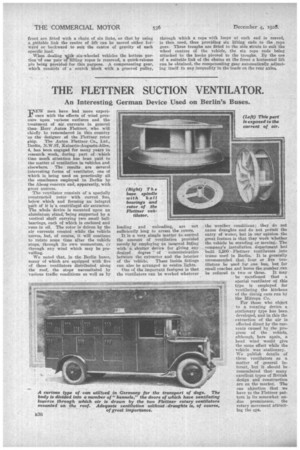THE FLETTNER SUCTION VENTILATOR.
Page 20

If you've noticed an error in this article please click here to report it so we can fix it.
An Interesting German Device Used on Berlin's Buses.
FFW men have had more experience with the effects of wind pressure upon various surfaces and the treatment of air. Currents in general than Herr. Anton Flettner, who will chiefly be remembered in this country as the -designer . of the Flettner rotor
ship. The Anton Flettner Co., Ltd., Berlin, N.W.87, Kaiserin-Augusta-Allee, 4, has been engaged for many years in research work, during part of .,which time much attention has been paid to the matter of ventilation in vehicles and elsewhere. The results. are several interesting forms of ventilator, one of which is being used on practically all the omnibuses employed in Berlin by the Aboag concern and, apparently, with great success.
The ventilator consists of a specially constructed rotor with curved fins, below which and forming an integral part of it is -a centrifugal air extractor. The whole device is mounted upon an aluminium stand, -being supported by a vertical shaft carrying two small ballbearings, each of which is enclosed and runs in oil. The rotor is driven by the air currents created while the vehicle moves, but, of course, it will continue to rotate some time 'after the vehicle stops, through its own momentum, cr through any wind which may be prevailing.
We noted that, in the Berlin buses, many of which are equipped with five of these ventilators distributed along the roof, the stops necessitated by various traffic conditions as well as by loading and unloading, arc not sufficiently long to arrest the rotors.
It is a very simple matter to control the amount of ventilation provided merely by employing an internal fitting with a shutter device for giving. any desired degree of communication between the extractor and the interior of the vehicle. These inside fittings can also be arranged as centre lights: One of the important feattges is that the ventilators can be worked whatever ....the weather conditions ; they do not cause draughts and do not permit the entry of water, but in our opinion the great feature is that they work whether the vehicle be standing or moving:. The company's installation department haS 'built 3,500 Flettner ventilators into . trams used in Berlin. It is generally recommended that four or five ventilators be used far one bus, but for small coaches and buses thenumher,can be reduced to two or three. It may be mentioned that a special ventilator of this type is employed for ventilating the kitchens of the dining cars run by the Mitropa Co.
For those who object to a rotating device a stationary type has been developed, and in this the extraction of the air is effected direct by the currents caused by the progress of the vehicle, although, here again, a head wind would give the same effect while the vehicle WAS stationary. Wo publish details of these ventilators as a matter of general interest, but it should be remembered thatmany excellent types of British design and construction are on the market. The one objection that we have to the Flettner pattern is its somewhat undue prominence, the rotary movement attracting the eye.






























